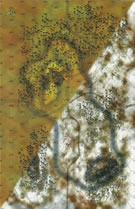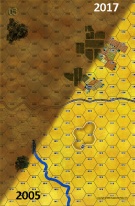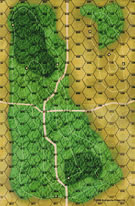| Author |
rerathbun
|
| Method |
Solo |
| Victor |
Japan |
| Play Date |
2011-06-19 |
| Language |
English |
| Scenario |
WaMa004
|
This is an enter-and-exit battle for the Japanese, a delaying action for the Australians. The Australians must defend a wide front, with two roads leading from the North (Japanese entry side) to the South (Japanese exit). I did apply one terrain mod not in the scenario instructions. The billabong ends at the western edge of Board 5. That looked odd to me, so I continued it onto board 18, through hexes 0717 and 0616 into the swamp at 0615.
The Australians set up first, with most of their units and minefields on the eastern half of the battlefield where the terrain is more open. They are badly outnumbered, and hope to use their minefields and entrenchments to hold the line against the Japanese. They have no real reserves. The Japanese also set up heavily in the east, with all of their armor and two-thirds of their infantry. The Japanese plan is to use their tanks and engineers to break through the thin Australian defense and make a break for the south, while the smaller Japanese force prevents the Australians in the west from reinforcing their comrades.
The Japanese advance on line to the minefields, and then deploy their engineers. Meanwhile, the tanks maneuver around the Australian right flank, losing two platoons to anti-tank guns before Japanese return fire takes them out. Japanese infantry assaults the entrenched Australians. It takes about two hours and some heavy losses, but the Japanese break through the Australian line, sending the few remaining Australians back to the woods in the south.
The Australians manage to get a few units into the woods on the southern boards while the Japanese regroup after their assaults. The survivors set up a small line of defense, but are too few to do more than slightly delay the Japanese at this point. The Japanese get most of units off the southern edge for a major victory.
In retrospect, I spread the defense too thinly along the front and tried to hold it too long. Once the Japanese broke through the line there was no stopping them. A defense in depth, with units concentrated along the road might have worked better. Still, a good scenario.
|





 WaMa003
WaMa003 




























